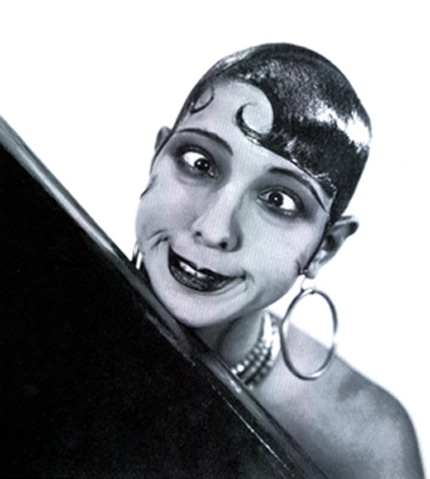Cross-Eyed and Painless
“Lost my shape – Trying to act casual!”
—Talking Heads, “Cross-eyed and Painless”

One of Baker’s most famous trademarks as “a funny woman” was in fact her most ostensibly nonsensical gesture—that of crossing her eyes. We’re told, “Baker mugged cross-eyed through her first solo appearance.” And she herself boasted, “At $125 a week, I was the highest paid girl in the chorus…. All because I could cross my eyes!” “Nothing very beautiful about a cross-eyed coloured girl,” wrote a reviewer for Dance Magazine in a laudatory review of one of Baker’s performances. “Nothing very appealing. But it was the folding knees and the cross-eyes that helped bring back the choruses for those unforgettable encores” (Dalton and Gates, 910). We might then ask what it means to cross one’s eyes. Why is this a “funny” gesture?
Clearly, it is nonsensical. It evokes the absurd. It crosses a line, as it were, within the realm of “logical” facial expression. But we might also consider the ways that this subtle move is also quietly wayward and oppositional. To cross one’s eyes is to draw attention to the physicality of the eyes and not the ass. When one crosses one’s eyes, one is looking two ways at once, refusing the gaze of the spectator, drawing the gaze in and yet disrupting attention and ways of looking. To cross one’s eyes is to short-circuit a way of looking at just one object. It is a form of looking, but not necessarily a form of looking at one’s audience. Eye crossing might be read as an almost enveloping gesture, one that signals the cross-eyed performer’s efforts to pull inward rather than returning the stares of onlookers. From this standpoint, we might read crossing one’s eyes as perhaps a refusal of sorts, as a resistance to engaging with the looker, and as a form of retreat. As the punk-new wave heroes the Talking Heads once put it in their late-seventies classic “Cross-eyed and Painless,” “I’m still waiting, I’m still waiting … Lifting my head, looking around inside.”
Baker’s “cross” to the inside—at the very moment when her outside was the subject of so much discussion—would no doubt register as an unexpected move and as yet another form of movement for the black female entertainer. And it is a gesture that situates Baker in relation to other eccentric performers who made their bodies move in unexpected ways: from the conjoined twins Millie and Christine of the antebellum era to the racially ambiguous antebellum star Adah Isaacs Menken, who rode across the stage in a flesh-colored bodysuit; from cakewalk superstar Aida Overton-Walker, who appeared in drag as the understudy for her husband George Walker on Broadway, to Hattie McDaniel, who successfully led her own all-female minstrel revue in Denver long before the wind done gone; from Moms Mabley, who appeared in burnt cork and danced her comic routines across the 1920s black vaudeville circuit, to the tragically underrated Jasmine Guy of the now defunct A Different World TV series, who found ways of manipulating a sly physical humor to match her sharp tongue and impeccable timing. (Yes, I just said that! Check out the Nick at Nite marathons and the episode in which she performs a Baker routine.)
And so, in closing, if anything, Josephine Baker’s work reminds us that we have a long way to go in recuperating the lost moves and the hidden genealogy of black female performers who found ways of making opaquely funny gestures with their own bodies and turning their own figures into wickedly double-vocal punch lines as a way to harness a means to an end in the public eye.
Many thanks to Farah Griffin and Kaiama Glover for inspiring me to explore Josephine Baker’s work in this context. I’d also like to thank Briallen Hopper, Camara Holloway, Noliwe Rooks, and Anne Cheng for their helpful suggestions and support while working on this piece. Special thanks to Reginald Jackson for his brilliant observations and feedback about Josephine Baker’s comedic and corporeal politics.



